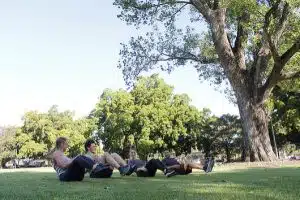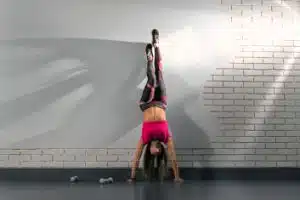Calisthenics has grown in popularity over the last 10 years, with stronger and stronger feats of strength being achieved.
But what exactly is it that causes this improvement in strength, and what can we do to maximise those gains.
Calisthenics also has a strong explosive based element to it, especially for those who do calisthenics freestyle.
In this in-depth article, I will show you the latest science in why our body reacts the way it does to strength training.
I’ll also explain which methods to train, depending on whether your goals are to get into freestyle or simply get as strong as you can.
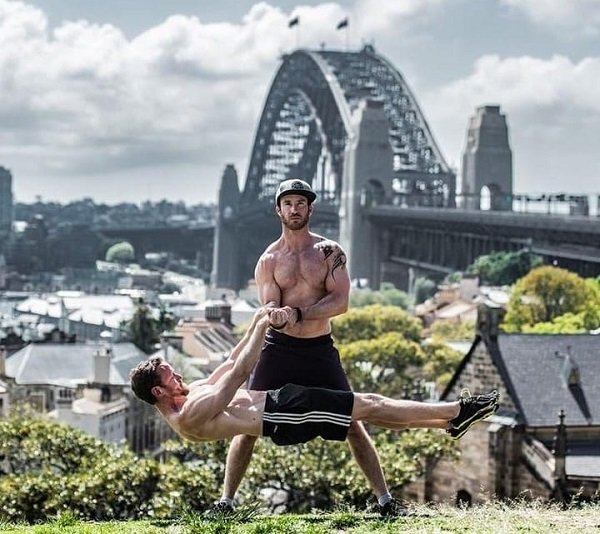
This will get quite technical, so if you’d rather have a simpler version, read these articles on how to build strength and build muscle with calisthenics.
You can also download a cheat sheet summarising the training protocol for different goals by simply filling in the form below.
Whilst this is aimed at calisthenics, the principles behind this apply just as well to weight-lifting / bodybuilding.
Table of Contents
Definitions
Before we get started, this article uses a few terms that you may not have encountered before.
If you already have good knowledge of the human body and strength training definitions, you may be able to skim past this section.
Agonist and Antagonist
When we move a joint, we have a shortening muscle (the agonist) and a lengthening muscle (the antagonist).
For example, during a bicep curl, the bicep is shortening and is the agonist, whilst the tricep is lengthening and is the antagonist.
The agonist is responsible for moving the joint, whereas the antagonist should relax and not get in the way of the moving joint.
Contraction Types
We move a joint by contracting a muscle.
There are 3 main types of contractions, concentric, eccentric and isometric.
Concentric Contraction
A concentrically contracted muscle is activating to shorten the muscle.
This is typically the “up” phase of an exercise.
Eccentric Contraction
A eccentrically contrated muscle is activating to lengthen the muscle.
This is typically the down phase of an exercise.
Eccentric only training is where you use outside resistance to perform the up phase (i.e. you climb to the top of the pull-up bar), then perform the eccentric contraction, usually slowly (i.e. slowly lower yourself from the top of the bar).
Isometric Contraction
An isometrically contracted muscle is activating whilst remaining the same length.
This most often happens during static holds such as a plank, but some muscle work isometrically whilst others are moving.
For example, during a push-up, your abs should be isometrically contracting to keep your pelvis tucked and stop your hips dipping.
Muscle Fibers
Our muscles are made up of thousands of muscle fibers; the biceps brachii has over 170,000 [1].
Our muscle fibers are made up of two main types, slow-twitch and fast-twitch.
Fast-twitch muscle fibers have more capacity for growth, contract quicker and produce more force than slow-twitch fibers.
Now, this is where it gets tricky as there isn’t just one standard way of classifying muscle fibers, but if we follow the Myosin Heavy Chain [2] classification, we can further split the fast-twitch fibers into type IIa and IIx/d.
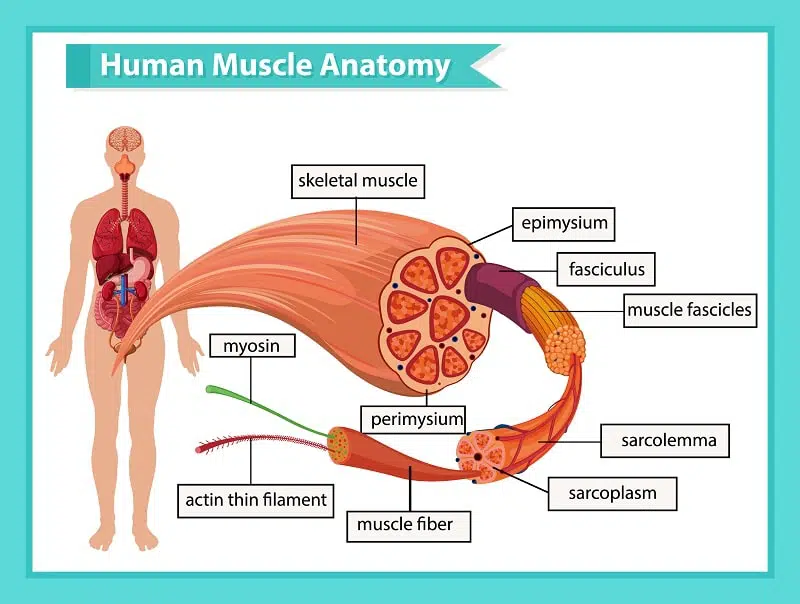
Type IIx/d produce more force, have more growth potential and are faster than type IIa but fatigue quicker.
Slow-twitch fibers, type I, are more resistant to fatigue and are suited to endurance and day-to-day activities.
We should not just assume every muscle fiber of the same type is the same though, they just have similar properties.
Force vs Velocity
Muscle fiber force is the direct measure of how much strength you can exert.
The more force, the heavier you can lift or the harder calisthenics progression you can manage.
Muscle fiber velocity is how fast the muscle fiber contracts or shortens.
The faster it can contract, the faster you shall move.
Muscle Fiber Power
Power is then Force x Velocity; the more you have of both, the more your power will increase.
For explosive moves like a muscle-up, backflip or pretty much any other calisthenics freestyle move, you need power.
For strength moves and static holds, you need force.
It’s important to differentiate between the two, as some adaptions for muscular strength will reduce your velocity, so if your goals are to do freestyle, you may want to limit some of these adaptions.
Whereas if your goal is to be a muscular beast, then you may be less worried about this and let your strength take care of your power.
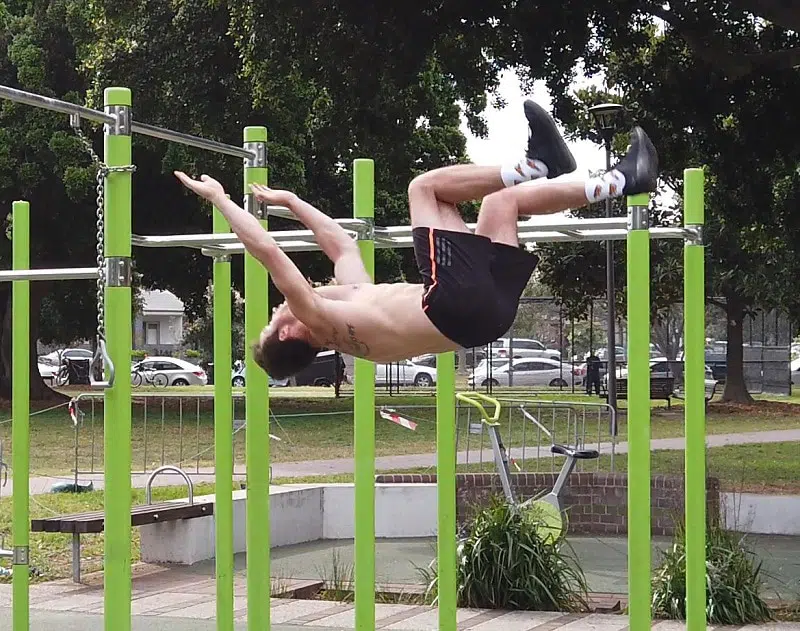
Energy Systems
All human cells use Adenosine Triphosphate (ATP) to generate force.
It is broke down from food sources and is the energy source of all living things.
The human body has 3 ways of breaking down ATP: the anaerobic alactic system, the anaerobic lactic system, and the aerobic system.
Whilst these 3 systems are mainly geared towards different levels of intensity; it’s important to realise that your body will at times be utilising all 3, just with different levels depending on the intensity of your workout.
The Anaerobic Alactic System (ATP-PC)
Translated as without oxygen, without lactate, this system uses ATP stored directly on the muscle, meaning it is extremely fast at delivering energy and is used for very intense, explosive movements.
As the name implies, it requires no oxygen or lactate to provide energy, meaning you’re not going to get out of breath or have a lactate build-up in your muscles using this system.
The drawback is that the muscle can’t store much ATP, meaning it lasts between 7 and 15 seconds, depending on the individual.
As the ATP is stored on the muscle, you can think of it as muscle-specific, though, so if one muscle has used up all its ATP, another resting muscle may still have fully replenished ATP.
The ATP is then reformed through the following chemical process:
- ATP breaks down into ADP and Pi when the muscle contracts.
- Phosphocreatine (PC) is then broken down into creatine and Pi.
- The energy released during this process allows ADP and Pi to rejoin to form more ATP.
This process is often referred to as ATP-PC. It takes around 3-5 minutes to reform fully.
The Anaerobic Lactic System
Translated as without oxygen, with lactate, this system converts carbohydrates (glycogen) to ATP.
Glycogen is stored on the muscle and transferred through the blood, so it is still quite a fast process.
With the increased need for glycogen transferred via blood, you’re going to see an increase in your heart rate in this zone.
This system leaves lactate on the muscle as a by-product.
If you’re above your lactate threshold, you will be making more lactate than can be metabolised and you won’t be able to sustain this level for long.
That burning feeling in your muscles is the accumulated lactate.
After one to two minutes depending on how well trained you are, this energy source will give in and you’ll see a significant decrease in your energy output (or you’ll need to stop moving entirely).
Once you stop, the lactate will start to be flushed out of your muscles using oxygen, so you’re likely to see an increase in your breathing.
If you’re below your lactate threshold, then you are metabolising lactate as fast as you make it.
At this level, you won’t be performing strength training though, which is more used for 20-30 minute steady-state cardio.
The Aerobic Energy System
Translated as with oxygyen, this system is only really used during your rest periods during a strength training session.
Your body will convert carbs, fats and protein into ATP.
This is the system that is used most of our lives, the higher the intensity, the more oxygen you will utilise.
Carb stores can last for around 90 minutes of sustained medium intensity exercise (think a 90-minute run), before your body starts to rely on fats and proteins to fuel it.
Fatigue
During your set, not only are you using up energy, but you are also accumulating fatigue.
There are three main types of fatigue, CNS (Central Nervous System) fatigue, peripheral (muscular) fatigue and muscle damage.
All three types of fatigue will accumulate through the workout, so whilst resting between sets will help, it won’t reverse the fatigue without stopping your workout and getting some proper R&R.

CNS Fatigue
When you have high levels of CNS fatigue, the electric signals sent to the muscle telling it to contract are reduced in size, resulting in reduced muscle fibre recruitment.
CNS fatigue happens most when doing high reps or performing sets close to or at failure [10].
Perhaps most importantly, the size principle states that the first muscle fibers to be affected by this fatigue are the biggest, fastest twitch fibers [11].
CNS fatigue is also not muscle-specific and will affect all of your muscles regardless of the ones just worked out.
As for how long it takes to recover, it can take several minutes between sets and accumulates throughout a workout.
2 hours after a workout, your CNS should return to normal except where muscle damage is present.
Peripheral Fatigue
This is the fatigue that takes place on the muscle being used.
It happens for several reasons, but the result is a force loss from the recruited muscle fibres.
The recovery of this depends on the type of fatigue.
Isometric and concentric contractions tend to fatigue quickly and recover quickly.
Eccentric contractions take longer to fatigue and recover.
Peripheral fatigue recovers quickly after a workout and will typically have returned to normal within an hour.
Muscle Damage
The primary cause of muscle damage is the forced lengthening of muscle fibers.
More muscle damage occurs with high volume compared to low volume, high intensity.
Furthermore, eccentric contractions cause more muscle damage than concentric contractions [12].
Peripheral fatigue also contributes to muscle damage.
I mentioned earlier that CNS fatigue takes longer to recover when there is muscle damage.
The exact mechanisms for this are unclear, but it seems reasonable to assume that the CNS would limit muscle fiber recruitment in areas with high muscle damage.
Muscle damage can take several days to fully recover, depending on the volume and contraction types of the workout.
Movement Patterns
In bodybuilding different parts of the body are split by muscle, with calisthenics we treat it a little different.
Whilst it is possible to isolate a muscle using your bodyweight, it’s not done as often and even then there’s going to be a lot more stabilisation going on.
For this reason we tend to split into movement patterns. The main 3 are:
- Push
- Pull
- Legs
This can then be further split into vertical and horizontal, glute vs quad-dominant and adding anterior, posterior and lateral chain:
- Horizontal Push (push-ups)
- Vertical Push (pike push-ups)
- Horizontal Pull (inverted row)
- Vertical Pull (pull-up)
- Vertical Anterior Chain (hanging leg raises)
- Horizontal Anterior Chain (hollow body hold)
- Vertical Posterior Chain (shoulder-stand leg raise)
- Horizontal Posterior Chain (straight bridge)
- Lateral Chain (side plank)
- Quad-Dominant (pistol squat)
- Glute-Dominant (shrimp squat)
Focus of Attention
The focus of attention is what the athlete is thinking about as they perform an exercise.
Internal Focus of Attention
This is where the athlete focuses their mind on their body.
For example, when performing a pull-up, they may focus on their lats engaging and what that looks and feels like.
External Focus of Attention
This is where the athlete focuses their mind on the world outside of the body.
For weight-lifitng this often involves focusing on the weight being moved; with calisthenics you are the weight, so this will usually focus on your body moving.

For example, during pull-ups they may imagine the bar as they do pull-ups and what effect their movement would have on it or they may imagine their chin passing the bar.
Mechanical Tension
Mechanical tension is an outside force trying to stretch a muscle whilst we use the muscle to resist.
In calisthenics (and most of the time in any other resistance training), that force is gravity.
For example, when performing push-ups, we attempt to shorten the tricep and anterior delt from a stretched position.
The force resisting this shortening and trying to stretch the muscle is our bodyweight, having gravity acted upon it.
To perform our push-up, we must produce more force than the amount of force being produced by our bodyweight in a push-up position.
The more mechanical tension, the harder it is to move, which results in a loss of velocity.
The lower the mechanical tension, the easier it is to move and maintain a high velocity.
What Are the Key Elements to Muscular Strength?
Many years ago I believed that it was just a simple case of the bigger your muscles were, the stronger you were.
Whilst muscle size does play a part in strength training, it is not the only factor at play.
So what are the key elements to muscular strength?
First I’ll explain what each of these elements is, then I’ll tell you how to improve them all.
Increased Intermuscular/Intramuscular Coordination
Characteristics
- Movement specific
- Improves quickly
- Improvements plateau quickly
- Velocity specific
- Is utilised heavily in calisthenics
Detailed Description
Intermuscular coordination can be defined simply as how efficiently your muscles work together within a given movement.
Whilst Intramuscular coordination is how well the fibers within a muscle work together.
For simplicities sake, I’ll refer to them both as coordination.
Coordination is movement specific, meaning that the more you perform that move, the more it will improve.
If a new movement is similar to one you have previously performed, then your nervous system can learn from the previous.
For example, if you try close hand push-ups for the first time, but are quite comfortable with push-ups, your body will take some coordination from your push-ups, so you’re not starting from scratch.
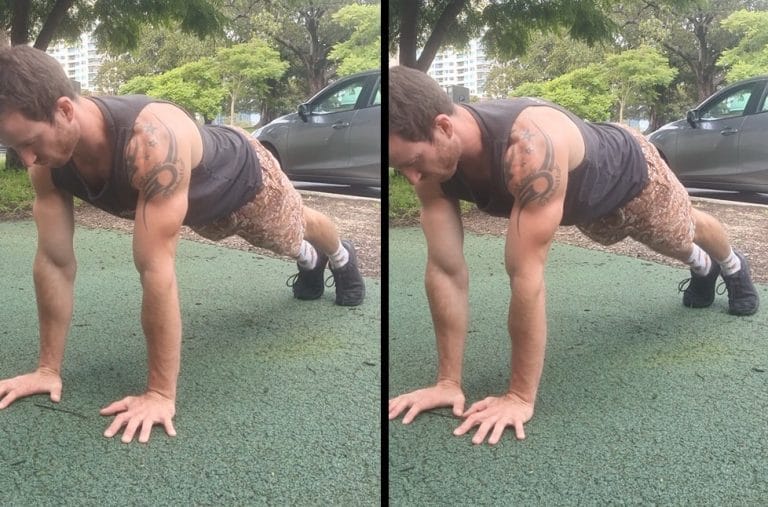
However, if a movement is quite different but works the same muscles, then you are unlikely to gain any coordination between the two; lat pull-downs won’t give you very much coordination for pull-ups.
Coordination is usually the first thing to improve when you start strength training; those first 2-4 weeks of improvements are mainly coordination improvements.
Once you’ve been training an exercise for a long time, you won’t get too much in the way of coordination improvements.
For calisthenics we can utilise this by moving to the next progression once we’re ready.
This means the consistent adjusting of exercises through progressive calisthenics will allow us to consistently see coordination gains.
Coordination Improvements When Weight-lifting
For weight-lifters adding more weight can sometimes adjust the exercise enough that you start to see further coordination improvements.
Adding all the weight in a specific spot will eventually change the dynamics of the move.
External Focus of Attention
Coordination has been shown to improve most when you adopt an external focus of attention.
This means you should envisage what your body looks like rather than as to how it feels.
This will allow your CNS to learn the movement more efficiently.
Force / Velocity Profile
Coordination is velocity specific, meaning your nervous system will treat different velocity versions of the same exercise as different exercises.
This means that if you’re trying to learn an explosive exercise, slow versions won’t help with the coordination.
For example, doing slow negative muscle-ups will not help build the coordination for an explosive muscle-up.
Instead, you’d be better to focus on easier explosive drills, such as a jump assisted muscle-up.
Improved Technique
Characteristics
- Movement specific
- Improvement speed depends on individual circumstances
- Is not velocity specific providing the technique remains the same
Detailed Description
As you improve your technique of a given exercise, you will find that your ability to perform it improves.
For example, if you can properly depress the scapula when performing pull-ups, your lats will activate more, giving you more strength.
It should be noted, though, that technique can be coordination specific.
Therefore, if you fix your technique, you may at first find the exercise more difficult as you build up the coordination for your new technique.
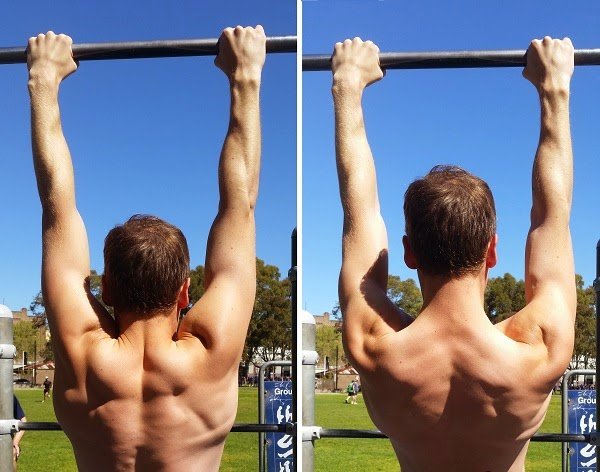
How quickly this improves depends on the individual and how much coaching you have had.
It’s not uncommon for us to teach people who have done pull-ups for years but don’t have the correct technique.
External Focus of Attention
Similarly to coordination, you should have an external focus of attention.
This will often mean thinking about specific technique points, such as tucking your pelvis during a push-up.
Force / Velocity Profile
Improving your technique will see improvements in both your slow and fast versions of an exercise, presuming the technique remains the same.
However, it can be harder to maintain technique when moving faster; ensure your form is solid before speeding up an exercise.
Increased Agonist Muscle Activation
Characteristics
- Not movement specific
- Can be muscle region-specific
- Has a contralateral training effect
- Is what gives the muscle memory effect
- Is not velocity specific
Detailed Description
Increased agonist muscle activation allows you to recruit more muscle fibres, specifically the fast-twitch fibres that allow you to lift a heavier weight or allow you to perform increasingly difficult feats of strength.
When you initiate a movement, your body will judge how much exertion is required and activate the appropriate muscle fibres.
For example, if you’re walking (and you’re not a toddler learning to walk), the body will realise this isn’t something that is too strenuous and will just activate your slow-twitch muscle fibres.
However, if you are doing an exercise that is really difficult and you’re on the last few reps that you can manage, your body will recruit more fast-twitch muscle fibres.
The more you activate a muscle fibre, the better your body becomes at activating more muscle fibres; the more muscle fibres you can activate, the stronger you’ll be.
Unlike coordination, muscle activation is not movement specific, so if you train your lats with a lat pull down, that extra lat recruitment will help you with your pull-ups.
It is however, muscle region specific, meaning that different areas of the muscle will get activated depending on the angle of your movement.
For example inverted rows and pull-ups both work the lats but at different shoulder angles. This doesn’t mean there is no carryover between these two exercises for muscle fibre recruitment, but it is limited.
Internal Focus of Attention
An internal focus of attention has been shown to improve muscle activation.
That is if you imagine your muscle activating and really focus on how it feels and looks, that muscle will recruit more muscle fibers.
Contralateral Strength Training Effect
Studies have shown that if you train just one limb for an exercise, the other untrained arm will still receive a small amount of increased agonist muscle activation [5].
Muscle Memory
When people talk about muscle memory and how you regain strength much quicker the 2nd time around, they are talking about agonist muscle activation.
That is because if you take a break from training, the gains you see in your activation remain for much longer than coordination and increased muscle fiber size.
This extra activation allows you to retain some of your strength, whilst also meaning that these muscle fibers will grow quickly as they’re already being activated.
Force / Velocity Profile
Improved agonist muscle activation will increase both your Force and Velocity.
Increased Muscle Fibre Size - Hypertrophy
Characteristics
- Is not movement specific
- Is muscle region-specific
- Will increase your force but decrease your velocity
Detailed Description
Increased muscle fibre size will result in an increase in strength.
This is often referred to as Hypertrophy.
Muscle fibre size is not movement specific, but it is muscle region specific, meaning you’ll see more growth in the areas of the muscle that you work.

Length vs Diameter
Muscle fibers can increase in length as well as diameter.
Interestingly, increased length only happens during eccentric contractions.
Increased diameter comes from concentric, isometric and eccentric contractions.
Muscle Repairs Before Increasing Size
It’s important to know that your body will prioritise repairing the muscle fiber damage as a result of training before it increases muscle fiber size.
This means that if you train too often you could be in a continuous cycle of repair, hindering your muscle growth.
Force / Velocity Profile
Increased muscle size will increase your Force. However, it will hurt your Velocity.
This means if you’re looking to get into calisthenics freestyle, you probably shouldn’t bulk up too much.
The extra weight will also make all other exercises a little more difficult.
Increased Tendon Stiffness
Increasing your tendon stiffness will help protect your joints and allow you to lift heavier weights or perform more difficult exercise progressions.
Imagine your tendons as an elastic band, thin bands aren’t very strong and don’t have as much power when stretched.
Thicker elastic bands are less likely to break and release with a lot more force when stretched.
It should be noted that tendon stiffness should not be confused with flexibility.
Force / Velocity Profile
Tendon stiffness helps increase Force.
There is conflicting research around Velocity and tendon stiffness, for example, Keitaro Kubo et al [3] found no difference in the tendon stiffness between sprinters and untrained individuals.
This could be explained that sprinting does not induce tendon stiffness rather than tendon stiffness not helping with Velocity.
Decreased Antagonist Muscle Activation
If increased agonist muscle activation makes you stronger, then it stands to reason that decreased antagonist muscle activation will also make you stronger.
It may seem counterproductive, but your body will activate some muscle fibres of the antagonist’s muscle.
It is widely believed this is for joint stability.
As you train more, your body will learn to decrease this muscle fibre activation.
This can take a long time to improve and is more likely to be seen amongst seasoned athletes.
Force / Velocity Profile
Decreased antagonist muscle activation will improve both your Force and Velocity.
Changes in Muscle Fibre Type
As discussed earlier, there are a few different muscle fiber types.
When we are born our muscle fiber type split between slow-twitch and fast-twitch tends to be about 50/50.
Depending on how we train, our muscle fibers can adapt to be better at your given training.
Furthermore, the most common changes are not as you might expect, it’s more common for muscle fibers to change from type IIx/d to type IIa.
This might seem counter-intuitive as type IIx/d produces more force, but type IIa are more resistant to fatigue, so it appears that the body tends to adapt for more fatigue resistance [2].
It seems that the body can change from type I to type II but there is conflicting research on this [4].
More research is clearly needed, especially on how to do it, how what percentage can be changed, different age groups etc.
How to Increase Muscular Strength
Now that I’ve determined the factors behind muscular strength, I’ll now dig into this deeper and explain how to optimise your training based on these elements.
How Many Reps To Increase Muscular Strength?
To figure out how many reps we want to hit for each strength factor, let’s look at what actually happens during these reps.
Due to the variance in intensity of an exercise pushed to your max for different rep ranges, I’ll split this up into 1-3 reps, 4-6, 7-12, 13-19 and 20+ reps.
For each, we are assuming an exercise that pushes you to failure or 1 rep shy of failure for these rep ranges.
We shall also assume for the set that we cover, that you are well-rested and fresh; we’ll get into subsequent sets later.
1-3 Rep Max
- This is your max strength, it’s going to push you to your limits to get these reps in.
- Your body will be primarily using ATP-PC for all of these reps, so you’re not going to have any shortage of energy.
- As a result of this, you won’t see a massive HR increase or get out of breath.
- As this is such a high-intensity exercise, your largest muscle fibers will activate from the get-go.
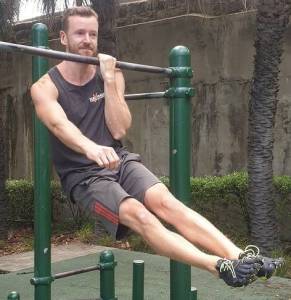
4-6 Rep Max
- This is still a very intense exercise, but not quite as intense as 1-3 rep max.
- The first 1-3 reps will be primarily using ATP-PC, reps 4-6 this will start to decline and you’ll use more of the Anaerobic Lactic System at lactate threshold.
- There will be a very small burning sensation in the muscles due to a build-up of lactate.
- Your HR and breath will be slightly increased to try and reduce the lactate build-up.
- This is still an intense exercise, so your biggest muscle fibers are likely to be active from rep 1.
7-12 Rep Max
- At 7-12 reps you are now performing an exercise that you are quite familiar with and have probably been able to do for a while.
- The first 1-3 reps will be primarily using ATP-PC, subsequent reps will shift more and more to your Anaerobic Lactic System at Lactate Threshold.
- By rep 5-6 your ATP-PC will almost certainly be depleted.
- Towards the last reps, you’re going to feel a significant burning sensation in your muscle as the lactate starts to accumulate in your muscles.
- Your HR and breath will increase to try and reduce the lactate build-up; how much of an increase depends a lot on your VO2 Max.
- During the first few reps your biggest muscle fibers are not currently needed and you’ll be using some of your smaller fast-twitch fibers.
- With around 5 reps to failure, these smaller ones will start to reach a level of fatigue where they require help from your biggest muscle fibers.
- Due to the increased blood flow from sending glycogen to your muscles you’re likely to feel “the pump” in your muscles after this set.
- Due to the burning sensation, you’re going to have to push past the pain to reach muscle failure, rather than “willpower” failure.
13-19 Max Reps
This will be a largely similar pattern to 7-12, with a few minor alterations:
- The first few reps will feel easy and as such your body won’t recruit too many of your fast-twitch fibers.
- Your HR and breath will see a further increase, depending of course on your VO2 Max.
- Once again for the last 5 reps or so, you’re biggest muscle fibers will kick in to provide assistance.
- The burning sensation will be tough and you’ll have to push through it to reach failure.
- There will be a temptation to stop moving, maybe resting at the top of a push-up; this is because even short breaks like this relieve a bit of lactate build-up.
- During this “rest”, you may find yourself taking in a lot of air, this is the bodies way of trying to assist you to reduce the lactate build-up.
20+ Max Reps
Once again, you will follow a similar pattern to 13-19 with some alterations:
- The first reps are likely to be so easy that you could be utilising more slow-twitch muscle fibers, as they are much more resistant to fatigue.
- The lower intensity of this exercise might drop you below your lactate threshold, depending on how many reps you can manage.
- There will be an increased amount of your Aerobic System to provide energy.
- This means you’re likely to get more out of breath, again, depending on your VO2 Max.
- The intensity of this exercise may not be enough to activate your biggest muscle fibers as you may experience CNS failure instead of muscle failure.
Now we’ve covered what is happening within your body during your set, let’s look at what this tells us for each strength factor.
Coordination
Coordination improvements happen when you first perform a new exercise (or if you add enough weight to change the dynamics of the exercise).
For this reason, you’re going to get most coordination gains in the 1-6 rep ranges.
Anything higher than this and you are performing an exercise that you are already good at and therefore your coordination improvements shall be limited.
Technique
The rep ranges for technique should be low, how low depends on how much technique improvement is required, whether you have a coach spotting you etc.
For moves that are mostly skill, like freestyle moves, you’re going to want to limit them to 1 rep at a time until you have the technique locked down correctly.
If you’re working on improving your technique, try to steer clear of muscle failure, as your form will likely break down as this happens.
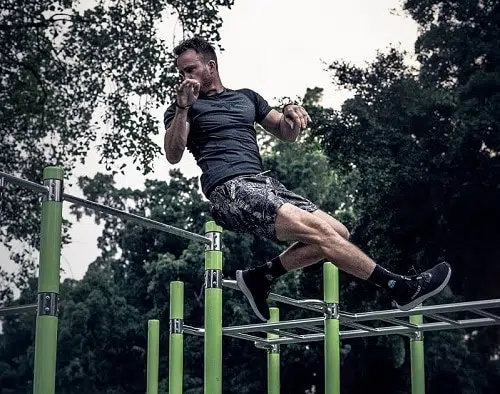
Agonist Muscle Activation
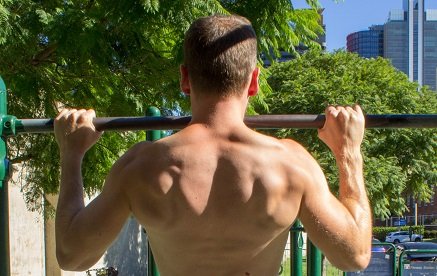
Agonist muscle activation, specifically your biggest fast-twitch muscle fibers that can produce the most force, improves as you activate them more.
This might sound like a chicken and egg situation but essentially forcing your body to be at enough intensity that it has to throw more muscle fibers at it, will force it to activate even more muscle fibers in the future.
Remembering that high reps produce more fatigue and that the size principle means that your biggest muscle fibers fatigue sooner.
For this reason, I’d recommend 10 reps or under trained at or close to failure to improve your muscle activation.
Muscle Fibre Size - Stimulating Reps Model
The stimulating reps model represents the latest in scientific breakthroughs into how and what causes hypertrophy, or increased muscle fiber size.
High Mechanical Tension
It was for a long period believed that muscle damage was the key driver behind hypertrophy.
However, we get plenty of muscle damage during a marathon but we know that that causes no hypertrophy.
In recent times the Stimulating Reps Model was produced that determined that muscle hypertrophy is caused by adequate mechanical tension.
In order for mechanical tension to be high, we must have an external force that is high enough that the force our muscle produce can only move at a slow velocity.
This maybe because the external force is high or our own force has reduced due to fatigue.
Power-Based Moves Don't Cause Hypertrophy
Since you can only achieve high mechanical tension during low velocities, power moves don’t cause hypertrophy.
Or do they? The explosive concentric won’t, but what about the other phases of an exercise? Let’s use a muscle-up as an example.
In the case of the muscle-up, it’s possible that you could get enough mechanical tension on the way down during the eccentric phase, depending on how controlled your descent is.
The transition could also cause some hypertrophy as we tend to slow down during this phase.
The dip phase is unlikely to cause too much hypertrophy as it is very rarely the point of failure for a muscle-up.
Train at or Close to Failure
Research has shown that hypertrophy can be caused with low or high reps and that training at or close to failure was the biggest driver behind hypertrophy.
The Stimulating Reps Model explains this because as long as we train at or close to failure, the last reps (stimulating reps) will achieve enough mechanical tension to induce hypertrophy.
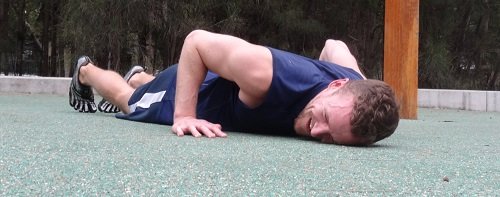
Most people can only get 5 stimulating reps per set.
This means if you’re training to set reps, let’s say 10, and you stop when you feel like you could have done maybe 2 more, you only achieved 3 stimulating reps.
Too few stimulating reps and you won’t maximise your muscle gains.
Too many reps and you will hit CNS failure rather than muscle failure.
Perform a minimum of 5 reps to failure, I wouldn’t recommend doing many more reps than 10.
Compound Moves
Compound moves are multiple joint movements, which means they utilise more than one primary mover to produce force.
In calisthenics, most of our movement patterns are based on compound movements.
This is argued is a good thing as it’s more functional and you can produce more force.
However, there is a good reason that bodybuilders perform a lot of isolation work.
If the goal is to produce enough mechanical tension in the muscle to induce hypertrophy by training at or close to failure, with a multi-joint movement, do all primary movers get 5 stimulating reps?
In most cases, the answer will be no.
For example, if we’re performing pull-ups to failure, the muscle most likely to fail and stop you from getting over the bar will be your lats.
For push-ups, it’ll probably be your triceps.
This means that our biceps/brachialis for the pull-ups and our chest for the push-ups, may not have reached enough stimulating reps.
If your goal is to be strong and not too much based on aesthetics, then this may not concern you.
Otherwise, you’re going to have to throw in some extra work for these areas.
We’ll get into this later when we talk about training for different goals.
Tendon Stiffness
Unlike muscle fiber size, research has found no coloration between training to failure and increased tendon stiffness.
What it has found is that high intensity exercises are key to increased tendon stiffness [13].
With that said, I would avoid regularly doing 1-3 rep exercises as they have an increased risk of injury; for that reason I’d recommend 4-6 reps where the last rep is only just shy of muscle failure.
Decreased Antagonist Muscle Activation
There is not currently enough research on how this happens, specifically around intensity.
My feeling is that it would be higher intensities in a similar way to increased agonist activation works.
Changes in Muscle Fiber Type
As previously mentioned, there is a lot of conflicting research around changes in muscle fiber type.
What is clear is that muscle fibers become more resistant to fatigue with higher volume.
This is for a trade-off in contraction speed, usually resulting in a switch from type IIx/d to type IIa.
Therefore, my recommendation is to keep reps in the 3-6 rep range, with your last being almost failure if you want more fast-twitch fibers.
How Much Rest Between Sets To Improve Muscular Strength
To figure out how long we need to rest between sets, let’s once again look at what’s actually happening during this rest period.
We’ll assume at least one set has been performed that was at or close to failure.
This is an estimate based on an individual who is used to strength training.

First 10 Seconds After Set
- Your ATP-PC started reforming the moment the ATP was used, even so, we’ve got a long time to go until we’ll be able to use this energy source again.
- The energy from your Anaerobic Lactate System will now start reducing and your Aerobic System will start to take back over.
- You’ll now be under the lactate threshold which means the burning sensation should start to subside.
- During the first 10 seconds you may see an increase in your breathing as your body takes on Oxygen to flush out the lactate.
- Your HR will drop as it no longer needs to be transporting glycogen to the muscles.
- The central nervous system and peripheral fatigue will both start to slowly recover.
First 30 Seconds After Set
- Your ATP-PC continues to reform.
- Depending on your VO2 max, your breath and HR may have returned to normal now.
- Your CNS and peripheral fatigue are reduced but a lot of the fast-twitch fibres that failed are still out of commission.
First Minute After Set
- Your ATP-PC continues to reform.
- Some of your fast-twitch fibers are now ready to go again.
1-2 Minutes After Set
- Your ATP-PC is now partially reformed, if you were to do your set now, it may last a rep or so.
- More of your fast-twitch fibers are back in action.
3+ Minutes After Set
- After 3 minutes your ATP-PC should be 85% reformed and ready to hit a few reps.
- Your fatigue is a lot better, but not all the fast-twitch fibers will come back with as much force as the last set.
- This won’t happen until you get a full rest and sleep.
Now that we’ve covered what is happening within your body, let’s look at what this tells us for each strength factor.
Coordination
Research has shown that coordination gains happen the most when more rested [14].
If it’s a tough exercise then you will need your ATP-PC and your biggest muscle fibers to be able to perform the exercise again.
For this reason, I recommend 3+ minutes of rest.
Technique
How much rest you take here depends on the intensity of the exercise; the more intense the exercise the more rest.
I’d recommend 1-3 minutes rest when working on your technique.
Agonist Muscle Activation
You get increased agonist muscle activation by using the muscle fibers.
For this reason, you need enough rest to allow as many of the fast-twitch muscle fibers to recover as you can.
I recommend 3+ minutes rest when working to increase muscle activation.
Muscle Fiber Size
You need to ensure you rest enough so that you’re going to continually reach muscle failure rather than CNS failure.
At the same time, the intensity of the exercise doesn’t have to be too high as long as you get enough stimulating reps.
I recommend 1-2 minutes rest for hypertrophy.
Tendon Stiffness
Increased tendon stiffness happens at high intensities.
To do this, we need enough time for your ATP-PC and fatigue to adequately recover.
I recommend 3+ minutes of rest.
Decreased Antagonist Muscle Activation
Just like the number of reps for this, there isn’t that much in the way of research.
I would recommend that we treat it similarly to Increased Agonist Activation and take 3+ minutes rest.
Changes in Muscle Fiber Type
The lower your rest, the more likely they are to adjust to be more resistant to fatigue.
If you want to have more fast-twitch muscle fibers, I recommend 2-3 minutes rest period.
How Many Sets to Improve Muscular Strength
Coordination
Since we need to perform at high intensities to improve coordination, we want to limit the number of sets to no more than we can manage without losing form or dropping too many reps.
Depending on the intensity of the exercise this may range from 2-5 sets.
Technique
This depends on how much skill is required for the technique you are practising.
If you’re practising an exercise that is highly skill orientated such as a handstand, then you will need to practise as many times as you can until you either run out of time, overall fatigue gets too high, or you feel like you’ve hit a wall.
In which case you may need to switch drills.
Agonist Muscle Activation
The more sets you perform, the more your CNS fatigue will build up, the less activation of your largest muscle fibers you’ll manage.
Too few sets and you may not activate them enough times to see the most improvement.
I advise aiming for 2-5 sets to optimise for this.
Muscle Fiber Size
Research has shown that an untrained individual can get away with just one round to failure in a workout [9].
Trained individuals can see improvements with just two rounds in a workout [9].
Moreover, research has shown that a maximum of 25 stimulating reps or 5 sets to failure is the most you can get out of one workout; any more than this and you won’t see any improvement [8].
Therefore I would recommend 2-5 sets to failure if you’re focusing on hypertrophy.
Changes in Muscle Fiber Type
Limiting your muscle fatigue and therefore reducing the number of adaptions that may slow down your muscle fibers is key to have more fast-twitch fibers.
For this reason, I would focus less on the number of sets and more on your rest periods and limiting muscle failure to optimise for this.
How to Structure Your Reps and Sets
There is more than one way to structure your rest periods combined with your reps and sets.
The traditional approach is to perform all your sets of a given exercise with set rest period, before moving to the next exercise.
This is a time-tested way of training but the average person usually wants to train for 45 minutes to an hour.
With the rest periods we’ve covered this is going to add up to a long workout with lots of rest, so what can we do to speed up the workout and make it more efficient?

Furthermore, are there any more modern structures that are delivering better results than the traditional method?
Let’s look at some of the modern methods of structuring a workout. Know of a method this is missing that’d you’d like me to cover? Then contact me and I’ll research it.
Superset / Giant Set
A superset is where you perform one round of two exercises back to back before moving onto the next set.
These two exercises are usually either opposing muscles (push/pull) or completely different (upper body/lower body).
A giant set takes this a step further and can have multiple exercises before moving onto the next set.
Advantages
- ATP-PC is muscle-specific, so the alternating of exercises will give your ATP more time to reform.
- Peripheral muscle fatigue will have more time to recover.
- This will allow you to get a lot more volume into a shorter space of time.
Disadvantages
- CNS fatigue is not muscle-specific, so you won’t be as strong as if you’d completely rested.
- Super setting opposing muscles makes it more difficult to have a plan that incorporates different muscle parts on different days.
Research has found that opposing muscle and upper body/lower body can produce enough mechanical tension to induce Hypertrophy, in a shorter time [6].
Beginner and intermediate calisthenics athletes will see good strength and hypertrophy gains with this format.
However, if you’re an advanced athlete, looking to get the maximum gains in strength, then maybe consider an alternative as there will be too much CNS fatigue to perform at your strongest.
Drop sets
A drop set is where you perform one set at or close to failure, then immediately follow it up with another set at greatly reduced intensity.
It is commonly used in body-building to get more volume in a shorter time period and, in theory, produce enough mechanical tension to induce hypertrophy.
With calisthenics, this would involve performing an exercise to failure, then immediately dropping it back a few progressions and performing to failure.
For example, maybe you perform tuck front lever rows to failure, then immediately follow it up with inverted rows to failure.
Advantages
- More total volume in less time.
Disadvantages
- No APT-PC recovery time.
- A build-up of CNS and peripheral fatigue
Studies have shown varying degrees of success with drop sets, but the overall picture is that they do produce as much mechanical tension as traditional sets.
I would not recommend them as a tool for building strength, however.
Back Off Sets
Back off sets are where you perform extra sets after your main working sets to add more volume for a particular exercise.
These are typically used to combine strength and hypertrophy by doing your most intense sets first with plenty of rest, then adding sets of higher reps and lower intensity to failure to ensure your muscles reach enough mechanical tension to induce hypertrophy.
With calisthenics, this might involve doing sets of 3-6 reps of a high-intensity exercise with plenty of rest, followed by sets of 8-12 reps of an easier progression with less rest.
For example, maybe you perform 3 reps on each side of archer pull-ups for 4 sets with 3 minutes rest. After this, you follow it up with 2-5 rounds of regular pull-ups to failure, with a minutes rest, regressing the exercise as needed to maintain the reps.
Advantages
- Allows enough rest to utilise ATP-PC and minimise fatigue for your strength sets.
- Covers almost every element of muscular strength.
- Allows for enough volume to induce hypertrophy.
Disadvantages
- If you’re looking for a 45 minute to 1-hour workout, then you won’t cover many muscle groups.
Studies have shown excellent promise with back off sets, even just adding as little as one back off set has shown an increase in hypertrophy [7].
Due to how many sets you’re probably going to perform with this of the same muscle groups, you’ll need to incorporate a split, which I’ll cover next.
The back off sets could also incorporate drop sets or super setting but I’d advise complete rest for your strength sets and resist the urge to decrease the rest period if you want to see the best strength improvements.
Calisthenics Workout Splits Compared
I’ve covered how many reps, sets, rest and the different ways of structuring the sets.
Next let’s look at how we can split up our workout throughout the week.
Full Body Vertical / Horizontal Split
- Most suited for beginners/intermediates
- 2-4 sessions a week
This is a good split for this wishing to get started with calisthenics.
The full body split will mean that you shouldn’t overdo it, otherwise it’ll lead to injury.
It consists of 2 workouts that can be performed alternating.
You can then potentially adjust the reps and sets to add more workouts if required.
Consider using a giant set to decrease the workout time.
This is the split we use in our calisthenics fundamentals.
Vertical / Horizontal Plus Legs Split
- Suitable for intermediates and above
- 3-6 sessions a week
For those wanting to work their legs more than just basic pistol squats, you can throw in an extra leg session.
As the upper body is still split between horizontal and vertical, I wouldn’t add any extra to the upper body workouts. The leg session can either be performed on a rest day or on the same day as your upper body. Supersets can be used to decrease the workout time.Push/Pull/Legs Split
- Suitable for intermediates and above
- 3-6 sessions a week
An alternative to the vertical/horizontal split is push/pull.
The advantage to this is you give more rest to muscles that carry over between horizontal and vertical, giving you less risk of injury.
Your upper body sessions could either combine horizontal and vertical or do them in separate workouts.
Supersets are not really worth it in this split for the upper body, so you may want to try drop sets to decrease workout time.
Training Skills
The final thing we need to think about in terms of a workout structure is when to practise our skills.
This depends largely on whether the skill is highly technical or highly strength based.
For example, a muscle-up has quite a bit of technique but once you have that technique, the best way to improve your muscle-up is to get stronger, plus a little bit of muscle-up practice.
However, a handstand requires a limited amount of strength but to master it you’re going to need to practise often.
For skills that require lots of strength, I would do a separate workout. You may need to replace one of your existing workouts to avoid overuse.
For skills that require lots of practice, consider giving yourself time before your workout to practice them.
Training Recommendations For Different Training Goals
That was a pretty exhaustive list of changes your body makes to increase muscular strength.
Some of these adaptions are suited to some goals and other adaptions for other goals.
I’m going to finish this article by combining this into 3 different goals, along with training protocols for those goals.
It’s important to note that some people may have a combination of these goals, in which case the protocol may need some modifications.
For all programs make sure you warm up properly with easier progressions and any appropriate mobility/activation.
Goal No.1 - Hypertrophy
This is an athlete who isn’t interested in skills and doesn’t see strength as the greatest priority.
Their number one goal is to add size.
This is not to say they won’t gain strength working this way but it’s not their main goal.
Main Training Objectives
- Increased muscle fiber size
- Increased agonist muscle fiber activation – increased activation has been shown to lead to increases in muscle size.
Training Summary
- Train to failure for every set except warm-ups even if this means going over the recommended reps, just increase the difficulty of the exercise next time.
- Aim for at least 5 reps per set including the failed rep, if they go below this, then decrease the difficulty for the next set.
- Perform at least 5 sets per exercise, if they failed to make 5 stimulating reps in any set add an extra set.
- Sets can be performed as super-sets or drop sets if they want to save time.
- Focus on the main movements, Horizontal Push and Pull, Vertical Push and Pull, Quad-Dominant and Glute Dominant.
- Consider adding some extra isolation work to cover muscles / muscle regions that may have been underused or missed.
- If their aim is to add weight, they will need to eat in a calorie surplus.
- An internal focus of attention should be made, specifically focusing on the prime movers of the exercise.
How to isolate each muscle with calisthenics is a little out of the scope of this article, but I’ll address it in future posts.
Example Program
For this example, we’ll utilise a push/pull/legs split performed 6 days a week with 1 days rest, but this is just one of many ways it can be done.
Pull
- 5 sets of vertical pull to failure with 2 minutes rest.
- 5 sets of horizontal pull to failure with 2 minutes rest.
- Finish with any extra isolation work they want to the biceps, forearms, abs (using the bar), rear delts, lats and rhomboids
To save time they may want to use drop sets, this can either be done with 3 sets and one drop set or two sets and 2 drop sets.
Push
- 5 sets of vertical push to failure with 2 minutes rest.
- 5 sets of horizontal push to failure with 2 minutes rest.
- Finish with any extra isolation work you want to the triceps, abs (using the floor), lateral delts, chest, front delts.
To save time they may want to use drop sets, this can either be done with 3 sets and one drop set or two sets and 2 drop sets.
Legs
- 5 sets of quad-dominant to failure with 2 minutes rest.
- 5 sets of glute-dominant to failure with 2 minutes rest.
- Finish with any extra isolation work you want to the quads, glutes, hamstrings, hip flexors, hip adductors/abductors, calves.
To save time they can use supersets or drop sets.
Supersets should be performed with opposing muscles, so quads/hamstrings, glutes/hip flexors, hip abductors/adductors.
Drop sets can be performed in the same way as push/pull.
Goal 2 - Strength
This is an athlete who wants to be the strongest they can be at calisthenics; if they put on some muscle in the process then great, but it isn’t their highest priority.
Main Training Objectives
Focusing on strength means they’ll want to see improvements in all areas, however these would be the top priorities:
- Increased coordination – every time they switch to a harder progression, they have the opportunity to further increase coordination.
- Increased agonist muscle fiber activation – the more muscle fibers they can recruit, the stronger they’ll be.
- Increased tendon stiffness – help protect the joint and increase their force transmission
Training Summary
- Will perform strength sets first.
- Then add extra hypertrophy back-off sets.
- For the strength sets it doesn’t matter if they reach failure or not as long as they are performing the hardest exercise they can for 3-5 reps.
- Hypertrophy sets should reach failure.
- A mixture of internal and external focus shall be used depending on how well the athlete activates specific muscles.
Example Program
For this example, we’ll utilise a horizontal/vertical/legs split performed 6 days a week with 1 days rest, but this is just one of many ways it can be done.
The number of sets can be adjusted depending on time and how much they want to prioritise strength or hypertrophy.
Vertical
- 2-6 sets x 3-5 reps of vertical pull with 3 minutes rest.
- 2-6 sets x 3-5 reps of vertical push with 3 minutes rest.
- 2-5 sets of vertical pull to failure super-setted with:
- 2-5 sets of vertical push to failure.
Horizontal
- 2-6 sets x 3-5 reps of horizontal pull with 3 minutes rest.
- 2-6 sets x 3-5 reps of horizontal push with 3 minutes rest.
- 2-5 sets of horizontal pull to failure super-setted with:
- 2-5 sets of horizontal push to failure.
Legs
- 2-6 sets x 3-5 reps of quad-dominant with 3 minutes rest.
- 2-6 sets x 3-5 reps of glute-dominant with 3 minutes rest.
- Finish with any extra isolation work you want to the quads, glutes, hamstrings, hip flexors, hip adductors/abductors, calves.
To save time they can use supersets or drop sets.
Supersets should be performed with opposing muscles, so quads/hamstrings, glutes/hip flexors, hip abductors/adductors.
Drop sets can either be done with 3 sets and one drop set or two sets and 2 drop sets.
Goal 3 - Calisthenics Skills and Freestyle
This is an athlete who wants to prioritise skills and freestyle.
Note if the athlete is not yet strong enough for some of the moves they are trying to perform, they may want to spend more time focusing on strength first.
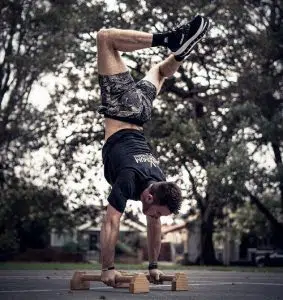
Main Training Objectives
- Coordination – each skill requires specific coordination, there shall be a big focus on improving this.
- Technique – as with coordination, each skill requires specific technique.
Training Summary
- Strength objectives will be focused around isometric holds and power.
- Several skill sessions will be included
- Avoiding muscle failure and not over fatiguing is important as that will affect their coordination and velocity and may see unfavourable muscle type changes.
- Up to 3 minutes rest between sets or “attempts” for skills; this will adjust depending on the intensity of the exercise.
- This athlete probably won’t want to do much leg work other than power and stretching, as big legs make all static holds more difficult as well as losing velocity.
- They will want a defined upper body but not too big, otherwise they will lose velocity.
Example Program
Skill training and how to program for this could be a whole article in itself and would probably be better written by Nathan than me as that’s his area of expertise but here is one possible way it could be done.
We’re going to split it into a power/static holds session and a skills session.
They should then throw in a full-body strength session 1-2 times a week.
How long each session is will be purely down to how much time the athlete has and/or how much energy they have.
Power / Static Holds
In this session the athlete will pick 2-3 exercises that they are working on, this could be a muscle-up, a front lever, human flag etc.
For rep based moves like the muscle-up, they should limit it to 1-3 reps; if they’re performing drills for a move they can’t do yet, they should limit to one before taking a rest.
Static holds should be limited to 5-10s max holds.
Take 2-3 minutes rest between each attempt.
This workout should performed 2-3 times a week, making sure to rest if / when required.
Skills Session
This maybe focusing on one particular exercise, like a handstand or there may be several skills that they are working on.
Focusing on one move is useful when working on moves that the athlete is not yet proficient at.
If doing more than one move, start with the ones that the athlete is least proficient at before “maintaining” the other moves.
Full Body Strength
Force = Power x Velocity
It’s all well and good to work on your power moves, but it’s important to not let the strength fade.
A full body 5×5 workout will be a good way to keep improving their strength.
See the Strong Lifts 5×5 Converted to Calisthenics for 2 example workouts for this.
Periodisation
Periodisation is a popular strategy to work on a specific area for a few months, before switching to a different plan.
There are many different ways to introduce periodisation into your workouts.
I’ll use the same examples of the previous athletes as to how they may introduce periodisation.
Goal 1 - Hypertrophy
Bulk / Cut Periodisation
For the athlete who is most interested in bulking, this may have been a periodisation in itself; sometimes we can use a bulking phase followed by a cutting phase.
In calisthenics, the cutting phase might be a good time to switch to a strength plan, similar to the one presented in Goal 2.
If the athlete chooses to do a bulk/cut periodisation, it is very important that they follow a suitable nutrition plan during these phases.
Target Different Muscle Regions
This is another popular one for those interested in how their body looks.
As previously mentioned, muscle fiber size and activation is muscle region-specific, meaning to hit every muscle fiber, we need to perform an exercise per muscle region.
Doing this in a week of training is very difficult, and this is why it can be done using periodisation.
As an example, the Pectoralis Major has 3 regions – clavicular (upper), sternal (middle), and costal (lower).
If we want to ensure that each area reaches enough stimulating reps, we may need several exercises rather than just one horizontal push exercise.
To achieve this, we may need to use periodisation to adjust the exercise to target different regions.
Goal 2 - Strength
Target Different Moves
With calisthenics there are many different moves that can be worked towards.
Due to the limitations around fatigure and how it affects strength gains, there’s no way we can work on all moves at the same time.
The best way is to do full body strength training, and target specific moves for specific movement patterns.
For example, a front lever is a horizontal pull (and horizontal anterior chain) as is a one-arm inverted row, as is a front lever row.
A dip is classified as a horizontal push as it works the same muscles, as is a planche push-up, a planche, and a one-arm push-up.
It’d be impossible to work on all these at the same time, so we periodise it.
This means you may work on your one arm push-up for a few months, then use the improved activation, muscle fiber size etc to help you with your planche push-ups.
Whilst you’re switching to another exercise, you will lose some coordination, but that will return quickly once you start doing that exercise again and the added strength from consistent training should ensure you progress quicker than before.
Goal 3 - Calisthenics Freestyle
Competition Season
In order to be good at freestyle, the athlete still needs to be strong.
Periodisation for a calisthenics freestyle athlete, may revolve around the competition season.
Let’s use an example where a particular athlete has 6 months of events that they want to enter, they’re then going to use the other 6 months as off season training.
During this period they would be better to focus on building their strength, increasing their muscle fiber activation, coordination for specific strength skills, even a little bit of hypertrophy.
This period they would still do some skill work, but more at a maintenance level rather than really try to get new skills locked in.
How long they might do this would depend on when their most important competition is, ideally it’d be at the end of the season but that’s not always the case.
They’d need to make sure they switched back to a focus on skills with plenty of time before their most important competitions.
Closing and FAQs
This brings a close to this in-depth guide on how to build muscular strength with calisthenics.
I hope you leave this feeling like your level of knowledge of how our body adapts to strength training is improved.
Thank you for taking time out to read this guide and I hope you got as much enjoyment in reading it as I did writing it!
There are so many more things that I haven’t covered that I could have, but this article could have ended up being a book if I wasn’t careful.
Now over to you, I want to hear all your questions on this, use the comments below or our contact page.
I will then add to this guide or write new articles based on the questions that follow.
FAQ
Does Calisthenics Build Muscle?
Yes absolutely, as we’ve determined, building muscle is caused by mechanical tension from training at or close to failure with reps that will limit your CNS fatigue.
Mechanical tension can be from internal or external weight as long as there is enough intensity to activate your fast-twitch muscle fibers.
To maximise your muscle growth you may need to include some isolation work to ensure all muscle regions are covered.
Can You Build Leg Muscles With Calisthenics
A year ago before I wrote the HyperStrong program, my answer would probably have been that you need to add some weights if you really want to build big legs.
However, I now happily answer that yes you can build muscley legs using just calisthenics.
The key is to follow the rules we’ve stated above, with extra emphasis on isolation for your quads, hammies and glutes.
I plan to write a detailed article on this in the future, which I shall link to once completed.
References
- Muscle fiber number in biceps brachii in bodybuilders and control subjects
- Human Skeletal Muscle Fiber Type Classifications
- Active muscle and tendon stiffness of plantar flexors in sprinters
- The Effects of Endurance, Strength, and Power Training on Muscle Fiber Type Shifting
- Unilateral strength training increases voluntary activation of the opposite untrained limb
- Maximizing Muscle Hypertrophy: A Systematic Review of Advanced Resistance Training Techniques and Methods
- MUSCULAR ADAPTATIONS TO COMBINATIONS OF HIGH- AND LOW-INTENSITY RESISTANCE EXERCISES
- What is the maximum number of stimulating reps that we can do in a workout for a muscle group?
- What is the minimum number of stimulating reps in a workout that will cause hypertrophy?
- Effects of fatigue duration and muscle type on voluntary and evoked contractile properties
- The size principle: a rule describing the recruitment of motoneurons
- Length-dependent changes in voluntary activation, maximum voluntary torque and twitch responses after eccentric damage in humans
- Patellar tendon adaptation in relation to load-intensity and contraction type
- Fatigue induces long-lasting detrimental changes in motor-skill learning

